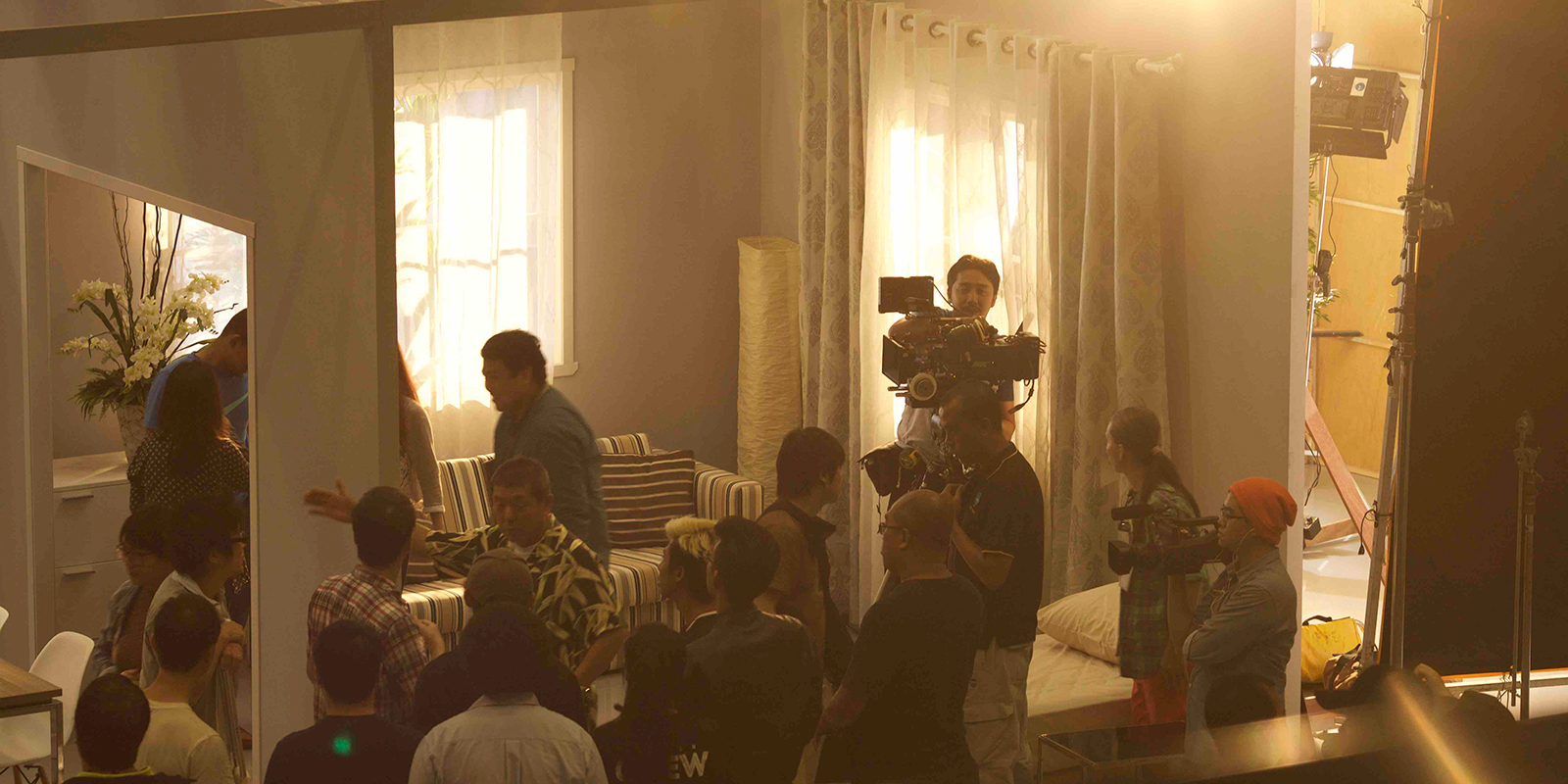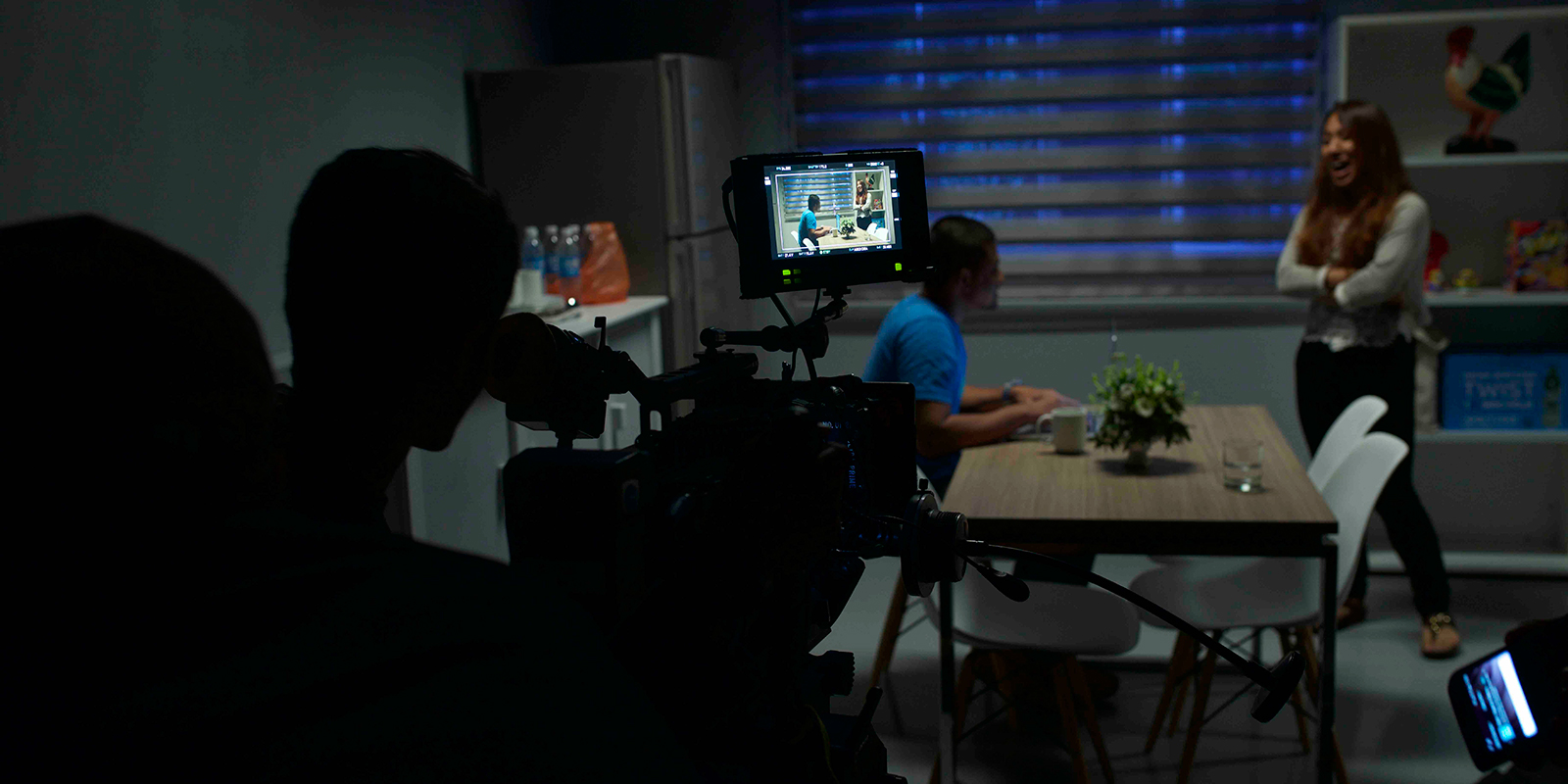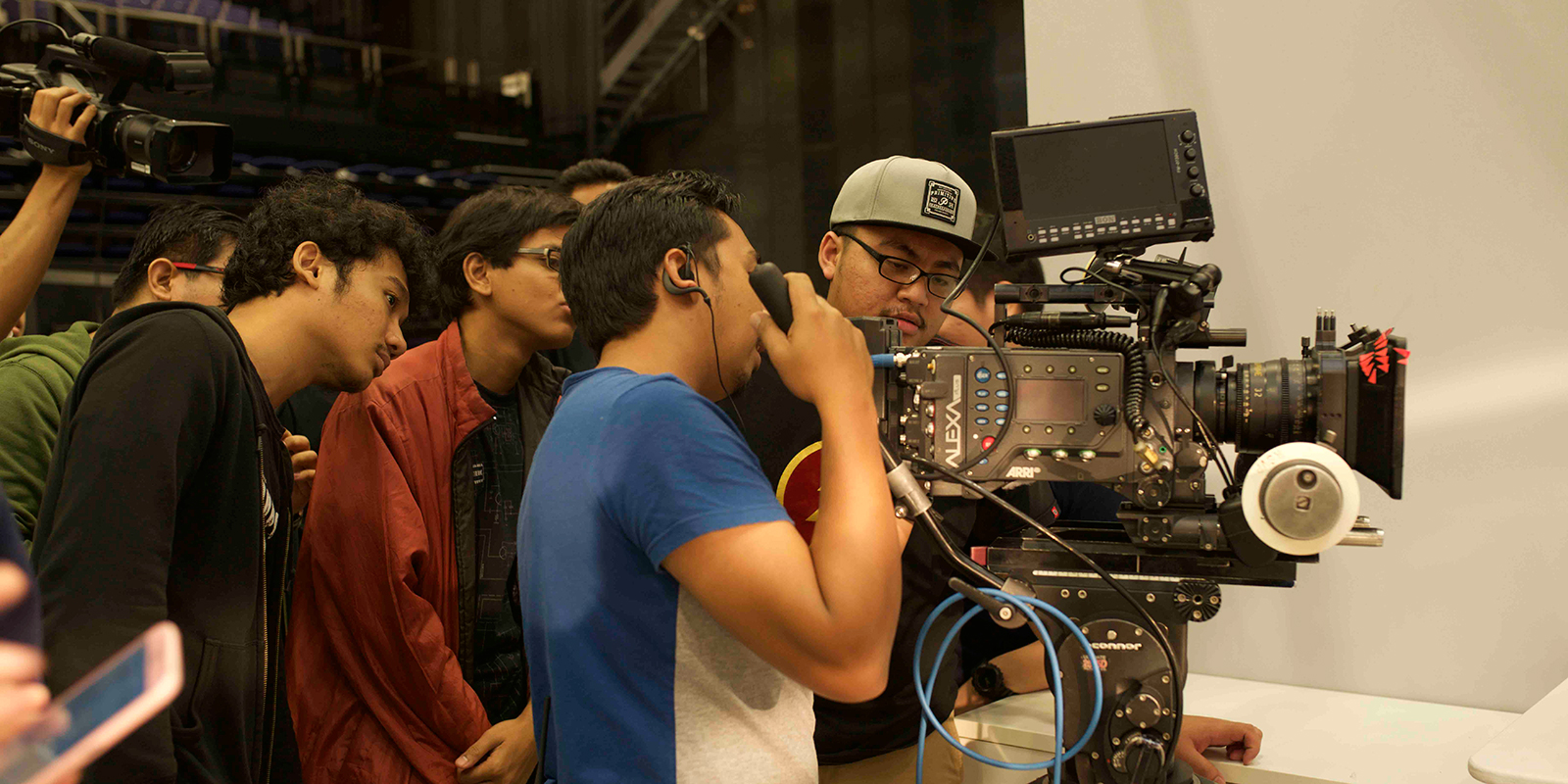Background and Purpose
Recent exponential development of the digital technology has brought significant and innovative changes to film production worldwide. Transition from film to digital took place and, thus, unconventional knowledge and technology related to film production is now required. Technological advancement enabled not only long shooting by digital media and high-definition filming such as 4K, but also improved the mobility with a downsized camera and realized technically advantageous shooting accessories such as MoVI and drone. With the spread of the digital technology, audiovisual expression became more and more diverse.
Recent Japanese cinema has been receiving certain international recognition with nominations and awards from international film festivals. It inherited film expression technique amassed during so-called Golden Age of Cinema in which a film production had been con- ducted in a studio. This was also the period when directors like Akira Kurosawa, Kenji Mizoguchi and Yasujiro Ozu globally played active roles in the industry. With such a history, today’s Japanese cinema scene has been actively applying the leading-edge digital technology to its film production. During the transition period from the film production to digital production, Graduate School of Film and New Media, Tokyo University of the Arts has been established in 2002 in order to provide film education and studies, as a first state-run university.
Against this background, this program aims to provide an opportunity for young Malaysian auteurs to understand experientially film expression technology of Japanese cinema, using the education method that the Department of Film Studies of this school has developed since 10 years. In concrete terms, we organized a master class and workshop for the students of the Faculty of Cinematic Arts at Multimedia University, a local private university in Malaysia. The purposes of this program were stimulating their creativity and encouraging further development of cinematic arts in Malaysia. Therefore, we set “Union of Japanese film expression technology and sensibility of Asian young auteurs” as the program theme.
The host country of this program, Malaysia, is still under development by international standards of film production, and only few directors have international visibility. However, the situation has been changing since the entertainment industry went into Johor District in which a massive urban-development plan “Iskandar Malaysia” has been implemented under the initiative of the government of Malaysia. Owing to the largest construction in Asia by Pinewood Iskandar Malaysia Studios (hereafter, “PIMS”) and a preferential treatment of subsidy in international joint production, Malaysia has potentiality of becoming a remarkable country in the film industry. In addition, different languages such as Malay, English and Chinese are used in the country, thus they do not have a language barrier and can target at the global market. We can say that Malaysia has significant possibilities.
However, Malaysia is still unknown in terms of human resources development that sup- ports the internal audiovisual culture and film industry. The participant university in the workshop, Multimedia University, was previously Institute of Telecommunication and Information Technology, established in 1994. It has been transformed into today’s university in 1996, and since then, has become one of the hubs for human resources development in the field of creative industrial development policy, encouraged by the government of Malaysia. Faculty of Cinematic Arts, newly established in Johor Bahru Area in 2013, collaborates with University of Southern California that has a long history of cinematic education, and offers practical education programs, holding a key to develop the film industry in Malaysia.
Moreover, the collaboration between Malaysia and Japan at the private level has also started. A major Japanese post-production company, IMAGICA went into PIMS and established Imagica South East Asia, a local corporation. This company is actively involved in the human resources development there, so we could organize a workshop with their assistance.
These favorable situations encouraged us to conduct the master class and workshop where the best environment has been given with a large film studio and the latest post-production facility. Our program aimed to offer an occasion for Malaysian youth to understand the Japanese cinematic arts and to experience techniques and ideas of a representative cinematographer of Japan and his passion for film making.
Implementation Structure
| Japanese Side | |
|---|---|
| Lecturer |
Katsumi Yanagijima (Cinematographer / Professor, Tokyo University of the Arts) |
| Assistant Lecturer | Mami Morisaki (Assistant Cinematographer) |
| Keisuke Ikeda (Lighting Technician) | |
| Director | Shogo Yokoyama (Assistant Professor, Tokyo University of the Arts) |
| Assistant Director | Yuko Nagoya (Freelance) |
| Assistant Director/Interpreter | Naoki Tanaka(Research Assistant, Tokyo University of the Arts) |
| Program Producer | Mitsuko Okamoto (Professor, Tokyo University of the Arts) |
| Program Manager | Asako Eguchi (Research Associate, Tokyo University of the Arts) |
| Planning / Operation | Graduate School of Film and New Media, Tokyo University of the Arts |
| General Management | UNIJAPAN |
| Program Supervisor | Takenari Maeda (Director, International Promotion Group) |
| Program Manager | Mayu Honda (International Promotion Group) |
| Malaysian Side | |
|---|---|
| Local Coordinator | Ken Kusaka (Imagica South East Asia) |
| Participating Educational Institution |
Multimedia University (Malaysia) |
| LASALLE College of the Arts (Singapore) | |
| Cooperating entities | Pinewood Iskandar Malaysia Studios(PIMS) |
| Red Circle Projects | |
| Iskandar Malaysia Creative Industry Talent Development Program | |
| Malaysian Society of Cinematographers | |
Lecturer’s Profile
-
Katsumi Yanagijima (Cinematographer / Professor, Tokyo University of the Arts)
Outline of the Program
《Program Name》
Camera and Lighting Workshop
《Schedule》
Wednesday, 25th November, 2015: Camera and Lighting Master Class
Thursday, 26th November, 2015: Camera and Lighting Workshop / Color Grading Workshop
《Venue》
Pinewood Iskandar Malaysia Studios (PIMS)
- Powell Theater (for Camera and Lighting Master Class, Color Grading Work- shop)
- TV Studio01 (Camera and Lighting Workshop)
《Time Table》
25th November: Camera and Lighting Master Class
10:00-12:00 Film Screening: “Like Someone in Love”(Director: Abbas Kiarostami / Cinematographer: Katsumi Yanagijima / 2012 / 109 min.)
12:00-13:00 Lunch
13:00-15:30 Lecture on camera and lighting
15:30-15:45 Break
15:45-17:30 Panel discussion
26th November: Camera and Lighting Workshop, Color Grading Workshop
10:00-12:00 Camera and lighting workshop
12:00-13:00 Lunch
13:00-16:00 Camera and lighting workshop
16:00-16:30 Break
16:30-18:00 Color grading workshop / Question-and-answer Session
《Participants》
Students: 32 persons
Affiliation of the Students:
Multimedia University (Faculty of Cinematic Arts): 24 persons
LASSALE College of the Arts (Faculty of Media Arts): 8 persons
Observer: Malaysian Society of Cinematographers: 14 persons
※Professionals in the Malaysian film industry participated as observers.
Details of the Program Contents
《Day 1:Camera and Lighting Master Class》
On the Day 1, we conducted the Camera and Lighting Master Class at the preview theater called “Powell Theater” inside PIMS. The class was divided into 3 parts; screening of the film, lecture on camera and lighting and panel discussion.
Film Screening (2 hours)
After the speech from Director, “Like Someone in Love” by Abbas Kiarostami was screened. Lecturer of the program, Mr. Yanagijima, was assigned as cinematographer for this film. This work was presented in the Competition Section at the 65th Cannes Film Fes- tival gained international recognition. In this film, Mr. Yanagijima’s camera technique has been maximized and also, Toshihiro Isomi, Professor of Art Direction at Graduate School of Film and New Media, Tokyo University of the Arts was assigned as art director (he assisted the design set for the camera and lighting workshop), and Shogo Yokoyama, Director of this program, was also engaged in this film as scripter / assistant editor . We selected this film since we could answer to various questions from the participants.
Lecture on Camera and Lighting (2 hours and 30 minutes)
After the screening, Mr. Yanagijima gave a lecture on camera and lighting. He talked about his camera techniques and the inside story of “Like Someone in Love”. He also showed still pictures that he took during the shootings of Director Takeshi Kitano’s films, and introduced the characteristics of Director Kitano’s filming and what kind of communication took place during the filming. Explaining his experiences of filming, he also referred to what he pays attention during the filming and his philosophy about filming. Furthermore, the topic went to today’s digital filming. He talked his view on the transition from film to digital, how he responded to the change, and the whole concept of being a cinematographer.
Panel Discussion (1 hour 45 minutes)
A three-way conversation among 2 members of Malaysian Society of Cinematographers (Mr. Mohd Filus Ghazali and Mr. Fendi Shareef Ang) and Mr. Yanagijima was carried out at the end of the Camera and Lighting Master Class. The topics of this conversation were the differences of filming systems between Japan and Malaysia, positioning of a cinematographer in film production, pre-production and filming location, role of a cinematographer during a post-production process, Mr. Yanagijima’s opinions on color grading and lighting, selection of lenses, digital filming in Japan and so on. Especially, they gave very technical information and and its contents was really interesting.
《Day 2:Camera and Lighting Workshop and Color Grading Workshop》
A practical workshop was held on the second day. The workshop was divided into 2 parts: Camera and Lighting Workshop and Color Grading Workshop.
Camera and Lighting Workshop (5 hours)
The Camera and Lighting Workshop was carried out in a studio for a TV program filming inside PIMS. This big studio has an auditorium that looks down a filming scene. The workshop was conducted as below.
In advance, the organizer had decided screenplays and renditions (acting) for 2 scenes, of which the students were also informed at the beginning of the workshop. The rendition plan was rather simple and acting was also limited since the workshop targeted at camera and lighting techniques. The lighting design focused changes from a dark place to a lighter place, use of shadows, differences among day-time, evening and night.
Mr. Yanagijima conducted the filming at an actual filming location, explaining how to select the camera position, angle and lenses to the students, along the screenplays and rendition plan. Regarding the camera angle, he used basic variations of size such as 2T’s (breast shot) in which actors’ facial expressions can be easily seen, and full figures that shows the whole room. Also, special equipment2 like dolly was used so that the participants could experience varied audiovisual expressions. Additionally, he also shot the same acting with both day-time and night lighting and tried to show the difference with the filmed scenes.
The participants had different levels of understanding on lighting, therefore, the lecture covered only the basics, and more technically explanations were added as necessary. Also, not only the lecturer, but also the clapper loader and gaffer actively explained their tasks.
All the filming processes could be observed by the participants near the lecturer and 2 monitors also were prepared so that the participants could see both the actual set and footages at the same time.
Moreover, the filming was regularly interrupted so that the participants could ask questions to Mr. Yanagijima. In the last half of the workshop, the participants could also use the camera together with Mr. Yanagijima, Assistant Gaffer and professional cinematographers of Malaysia.
Color Grading Workshop (1 hour and half)
After the Camera and Lighting Workshop, the venue was shifted to Powell Theater inside PIMS, and the Color Grading3 Workshop was carried out.
The color grading was performed by Mr. Andreas Brueckl, a dedicated grader of Imagica South East Asia, and Mr. Yanagijima. Mr. Yanagijima explained the basic methodology about color grading and its positive and negative effects, using the filmed material.
In order that the participants understand better and deeper about the color grading processes, a three-way conversation was held among Mr. Yanagijima, Mr. Brueckl and Mr. Kusaka from Imagica South East Asia. During the conversation, ideas on post-production by Mr. Yanagijima, differences in post-production and work flow in Japan and Malaysia, how a color grader and cinematographer interacts were discussed. Since real experiences by post-production specialists were presented, its contents were very fruitful.
The later part of the second part was a question-and-answer session. Not only the students, but also the observers asked questions, and its diverse topics were about camera techniques, human relationship at filming locations, questions about post-production etc. The master class took longer than expected due to questions from the committed participants.
Conclusions
Malaysia is the most active country that works on the industrial development of the film and animation among ASEAN countries with its own national strategy. The center of the film production is the Johor District where the huge urban development planning has been introduced. In this district, educational institutions such as MMU have been established in order to attract a big film studio like PIMS and to develop young professionals of the industry. However, the project of this district has just started so time is needed to bear fruit of the development project.
Considering the situation mentioned above, our program in the film field aimed to organize a practical and high-level workshop with the Japanese educational methodology. In concrete terms, we used the educational methodology that is applied to film studies courses at Graduate School of Film and New Media of Tokyo University of the Arts, and limited the program content to camera and lighting. We assigned Mr. Yanagijima who is a globally famous cinematographer as the lecturer and carried out the master class to show the philosophy for filming along with the workshop.
These approaches were quite successful with the favorable reactions from not only the participated students and local staff but also local professional cinematographers who assisted as observers.
However, the time of the workshop was limited and the number of the participants was more than expected. As a result, not everybody could actively participate in the filming process. The flow and length of a workshop should be reconsidered and improved in the future.
Lastly, if there is the most important key to make this program successful, it should be to develop a trusting relationship and obtain full cooperation with the educational institutions and the companies who will locally support the program. This would be a common issue required not only in Malaysia but also in any other countries.




